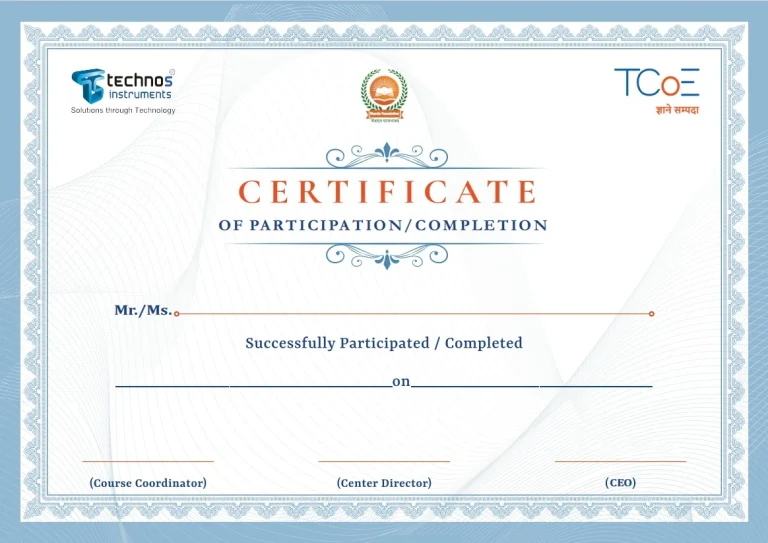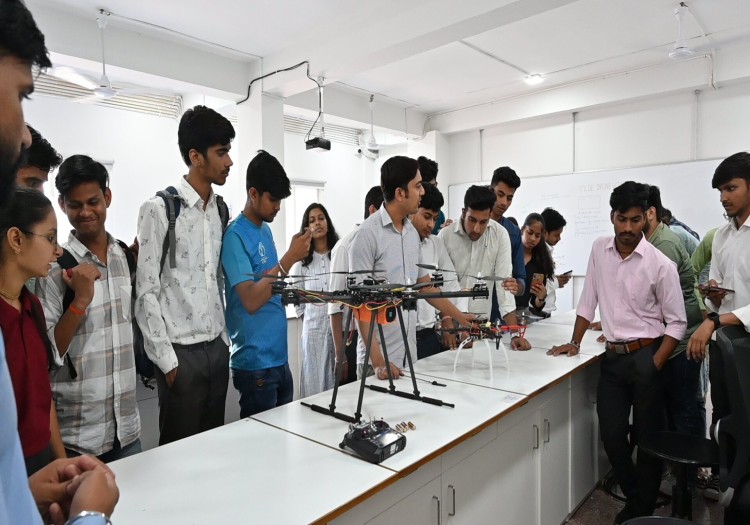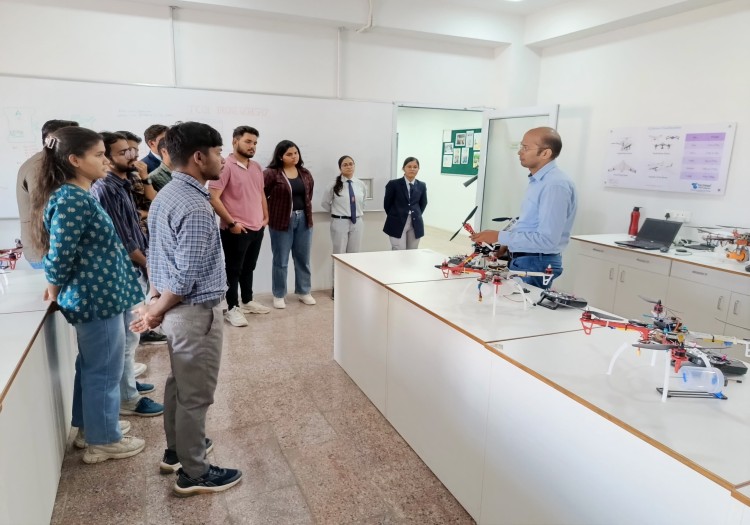Step into the world where connectivity meets security! This course introduces you to the principles of cybersecurity tailored for IoT devices, teaching how to protect smart systems from vulnerabilities and cyber threats. Learn to safeguard networks, secure data, and implement robust security protocols in the rapidly growing Internet of Things ecosystem.
- 72 Hours (2 hours/day x 6 days/week x 6 weeks) OR at your own pace
- Hindi, English
- Learn & Get Certified
- Basic & Intermediate
- Hands-On Training
About this course
The “Cybersecurity in IoT” course introduces learners to the fundamentals of securing Internet of Things (IoT) systems and networks. It covers key concepts such as IoT architecture, common vulnerabilities, data protection, and threat mitigation techniques. Learners gain hands-on experience in securing IoT devices, implementing authentication protocols, and managing risks associated with connected systems. This course prepares participants to design and maintain safe, resilient IoT solutions in today’s digitally connected world.
This course provides essential knowledge and practical training to build industry-relevant skills.
- Fees: ₹35,000 ₹23,000 (incl. GST) (Excluding tools & equipment cost)
- Certification: ESSCI
- Duration: 72 Hours (2 hours/day x 6 days/week x 6 weeks) OR at your own pace
What you'll learn
After this course you will be able to:
- Fundamentals of IoT Security: Understand the unique security challenges of connected devices and networks.
- Threats and Vulnerabilities: Learn to identify potential cyber attacks targeting IoT systems.
- Security Protocols & Encryption: Explore techniques to secure data transmission and device communication.
- Network Security for IoT: Gain skills in protecting IoT networks from unauthorized access and breaches.
- Hands-On Security Implementation: Apply security measures on IoT devices and simulate real-world scenarios.
- Risk Assessment & Management: Learn strategies to evaluate and mitigate security risks in IoT deployments.
- Real-World Applications: Discover how cybersecurity is applied in smart homes, healthcare, industry, and smart cities.
Course Content
How to use online TCoE platform?
Advantages of this course
Tools and Equipment required
National Skill Development Mission
Module 1: Introduction to IoT Ecosystem (6 Hours)
- This module introduces the foundational concepts of the Internet of Things (IoT).
- Learners will explore the IoT architecture, hardware components (sensors, actuators, microcontrollers), communication models, and real-world applications across domains like smart homes, healthcare, and industry.
- It builds the conceptual base for understanding how connected systems operate and communicate.
Module 2: Fundamentals of Cybersecurity (6 Hours)
- Students are introduced to cybersecurity principles—Confidentiality, Integrity, and Availability (CIA triad).
- This module explains types of cyber threats, common attack vectors (malware, phishing, man-in-the-middle, DoS), and basic protection strategies.
- It emphasizes risk assessment, threat modeling, and the importance of digital hygiene in IoT environments.
Module 3: IoT Networking and Protocols (8 Hours)
- This module explains how IoT devices communicate using specialized protocols and network architectures.
- Learners study MQTT, CoAP, HTTP, LoRa, Zigbee, Wi-Fi, and Bluetooth Low Energy (BLE) — along with their security limitations.
- Practical sessions include setting up MQTT brokers and observing packet flow using tools like Wireshark.
Module 4: Threats and Vulnerabilities in IoT (8 Hours)
- Students analyze vulnerabilities across IoT layers — perception, network, and application.
- Topics include insecure firmware, default credentials, data leaks, and weak encryption.
- Real case studies like Mirai Botnet and smart camera hacks illustrate the practical implications of IoT insecurity.
Module 5: Secure IoT Architecture Design (10 Hours)
- This module focuses on designing secure IoT systems from the ground up.
- Learners study secure boot mechanisms, firmware signing, encryption standards (AES, RSA, ECC), authentication methods (OAuth, JWT), and Public Key Infrastructure (PKI).
- Hands-on examples demonstrate secure communication between IoT nodes and cloud servers.
Module 6: IoT Device Security – Hands-On (10 Hours)
- Participants configure real IoT hardware (ESP32, Raspberry Pi, NodeMCU) for secure data transfer.
- They implement HTTPS communication, SSL/TLS certificates, and encrypted MQTT messaging.
- The focus is on practical protection of device firmware, credentials, and communication channels in embedded IoT systems.
Module 7: IoT Network & Cloud Security (10 Hours)
- This module covers network-level and cloud-based security measures.
- Students learn about VPNs, firewalls, intrusion prevention systems, and network segmentation.
- They explore security settings on AWS IoT Core and Azure IoT Hub, including encryption-at-rest, role-based access control (RBAC), and data integrity verification.
Module 8: Intrusion Detection and Monitoring (8 Hours)
- Learners are trained in identifying, analyzing, and mitigating cyberattacks.
- Topics include intrusion detection systems (IDS), intrusion prevention systems (IPS), honeypots, and log analysis.
- Tools such as Wireshark, Snort, and Security Onion are introduced for monitoring IoT network traffic and detecting anomalies.
Module 9: Case Studies and Projects (6 Hours)
- This module provides practical exposure through guided case studies and real-world projects.
- Learners design and simulate secure IoT applications such as smart homes, industrial automation, or healthcare monitoring systems.
- Emphasis is placed on implementing learned security mechanisms and documenting results.
Module 10: Assessment and Certification (Final Evaluation)
- The final module includes a comprehensive evaluation — written test, viva, and project presentation.
- Students are assessed on theoretical understanding and practical implementation of IoT security measures.
- Successful participants receive a certification validating their proficiency in Cybersecurity for IoT systems.
Browse Online Drones Certificates
Find new interests and advance your career opportunities!








Browse Online Drones Certificates
Find new interests and advance your career opportunities!








ENROLL TODAY & GET 30% OFF ON ALL COURSES
Your Future Can’t Wait, Enroll Now and Save 30% On All Courses. Hurry Up Offer valid Till Diwali
Our Related Courses
See what our students have to say
With over a decade of experience, our mission is to produce future-ready skilled resources.


Securing IoT Networks Against Cyber Threats
This topic explores how connected devices communicate, where vulnerabilities arise, and how hackers exploit them. You’ll learn techniques like encryption, authentication, and intrusion detection to protect IoT systems, ensuring that smart homes, healthcare devices, and industrial IoT networks remain safe from cyber attacks. It’s a perfect blend of theory and practical strategies for real-world protection.
Job Opportunities
Here are some interesting job opportunities after completing the Cyber Security in IoT course:
IoT Security Specialist – Design and implement advanced security measures to protect connected devices and networks.
Cybersecurity Analyst – Monitor, detect, and respond to cyber threats targeting IoT systems and smart environments.
Network Security Engineer – Secure communication channels and prevent unauthorized access within IoT infrastructures.
Embedded Security Engineer – Develop and secure firmware and embedded systems in IoT devices.
Penetration Tester (IoT Focus) – Identify vulnerabilities in IoT systems through ethical hacking and security testing.
Security Operations Center (SOC) Analyst – Analyze real-time data to detect and mitigate IoT-based cyber incidents.
IoT Solutions Architect – Design secure, scalable IoT ecosystems integrating robust cybersecurity frameworks.
- Research & Development Engineer – Innovate new methods for securing emerging IoT technologies and applications.
Frequently asked questions
What is Cyber Security in IoT?
It is the practice of protecting Internet of Things (IoT) devices and networks from cyber attacks, data breaches, and unauthorized access.
Who can take this course?
Anyone interested in IoT, cybersecurity, or technology — beginners, students, and professionals can benefit.
Do I need prior knowledge of programming or networking?
Basic understanding helps, but the course is designed to teach concepts from the ground up.
What skills will I gain from this course?
You’ll learn to identify vulnerabilities, implement security protocols, secure IoT networks, and manage cyber risks.
Are there practical exercises in this course?
Yes, the course includes hands-on simulations to apply cybersecurity measures on IoT devices and networks.
How long is the course?
The course can typically be completed in a few weeks, depending on your pace and practice.






